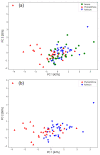Electronic Nose Differentiation between Quercus robur Acorns Infected by Pathogenic Oomycetes Phytophthora plurivora and Pythium intermedium
- PMID: 34500705
- PMCID: PMC8434229
- DOI: 10.3390/molecules26175272
Electronic Nose Differentiation between Quercus robur Acorns Infected by Pathogenic Oomycetes Phytophthora plurivora and Pythium intermedium
Abstract
Identification of the presence of pathogenic oomycetes in infected plant material proved possible using an electronic nose, giving hope for a tool to assist nurseries and quarantine services. Previously, species of Phytophthora plurivora and Pythium intermedium have been successfully distinguished in germinated acorns of English oak Quercus robur L. Chemical compound analyses performed by HS-SPME/GC-MS (Headspace Solid-Phase Microextraction/Gas Chromatography-Mass Spectrometry) revealed the presence of volatile antifungal molecules produced by oak seedlings belonging to terpenes and alkanes. Compounds characteristic only of Phytophthora plurivora or Pythium intermedium were also found. Methylcarveol occurred when germinated acorns were infected with Pythium, while neophytadiene (isomer 2 and 3) occurred only when infected with Phytophthora. Moreover, isopentanol was found in acorns infected with Phytophthora, while in control, isopentyl vinyl ether was not observed anywhere else. Among the numerous volatile compounds, isopentanol only occurred in acorns infected with Phytophthora and methylcarveol in acorns infected with Pythium.
Keywords: VOC; fungi and biosecurity; odor classification; volatile organic compounds.
Conflict of interest statement
The authors declare no conflict of interest.
Figures





References
-
- Jung T., Orlikowski L., Henricot B., Abad-Campos P., Aday A.G., Aguín Casal O., Bakonyi J., Cacciola S.O., Cech T., Chavarriaga D., et al. Widespread Phytophthora infestations in European nurseries put forest, semi-natural and horticultural ecosystems at high risk of Phytophthora diseases. For. Pathol. 2016;46:134–163. doi: 10.1111/efp.12239. - DOI
-
- Gisi U., Sierotzki H. Oomycete fungicides: Phenylamides, quinone outside inhibitors, and carboxylic acid amides. In: Ishii H., Hollomon D., editors. Fungicide Resistance in Plant Pathogens. Springer; Tokyo, Japan: 2015. pp. 145–174. - DOI
-
- Griffith J.M., Davis A.J., Grant B.R. Target sites of fungicides to control oomycetes. In: Köller W., editor. Target Sites of Fungicide Action. CRC Press; Boca Raton, FL, USA: 1992. pp. 69–100.
-
- Ziogas B.N., Markoglou A.N., Theodosiou D.I., Anagnostou A., Boutopoulou S. A high multi-drug resistance to chemically unrelated oomycete fungicides in Phytophthora infestans. Eur. J. Plant Pathol. 2006;115:283–292. doi: 10.1007/s10658-006-9007-6. - DOI
MeSH terms
Substances
Grants and funding
LinkOut - more resources
Full Text Sources
Miscellaneous

